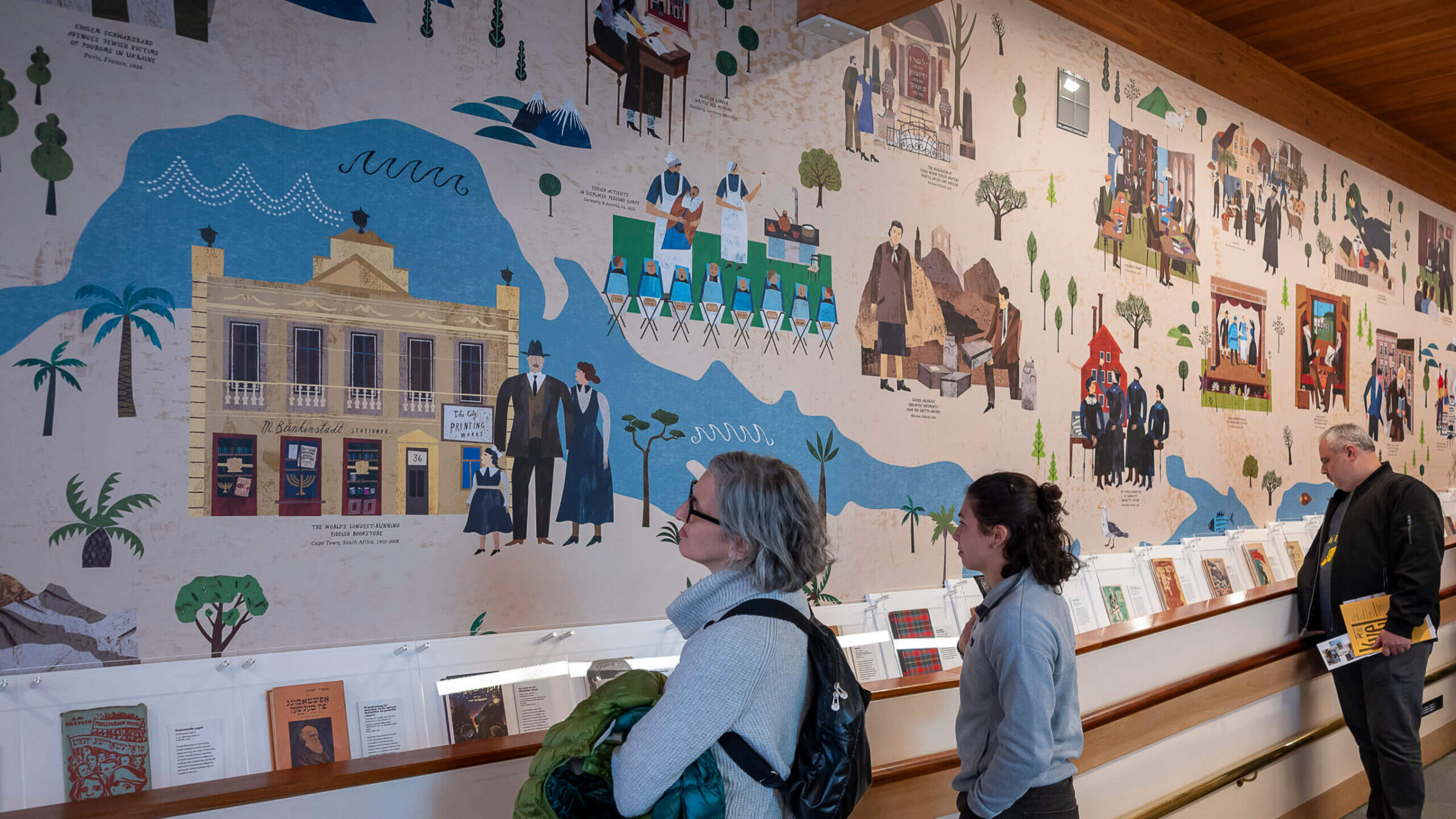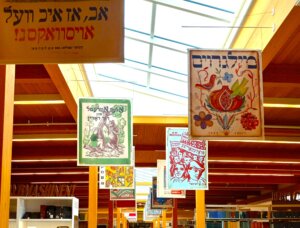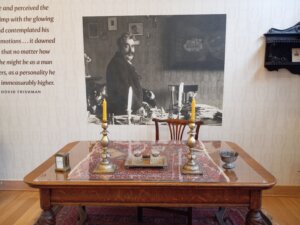Magnificent permanent exhibit opens at Amherst’s Yiddish Book Center
Among the many displays are a 1918 Yiddish linotype press and a replica of the great Yiddish writer Y.L. Peretz’s study in Warsaw

A colorful 60-foot mural depicting the history of Yiddish culture, commissioned for the Yiddish Book Center’s new permanent exhibit from German illustrator Martin Haake. Photo by Ben Barnhart
The Yiddish Book Center in Amherst, Massachusetts, recently got a total makeover.
The center, one of the preeminent Yiddish institutions in the world, offers a wide variety of indispensable resources on its website for researchers and Yiddish enthusiasts alike. But since its founding in 1980, its vast collection of books and other materials has mainly lived in underground vaults and off-site storage facilities — largely inaccessible except to researchers visiting by appointment.
All of that has now changed. The center’s new permanent, public exhibition, Yiddish: A Global Culture,” features hundreds of books, photographs, works of art, memorabilia and other objects displayed in a large and beautifully organized exhibit space. The Yiddish Book Center has transformed itself into a unique museum and showcase of Yiddish material culture.

“We wanted to make Yiddish culture cool. Seriously cool,” said David Mazower, the chief curator and writer for the exhibition. Stereotypes about Yiddish as dead or dying or irrelevant needed to be swept away. The vitality and daring of Yiddish literature, art, music, journalism and theater — which burst onto the international scene in the late 19th century, and never paused to breathe until the catastrophe of the Holocaust — needed to be shown to Jews themselves and to the world in its true and brilliant colors.
Shakespeare’s sonnets in Yiddish
The exhibit is housed in the main building at the heart of the complex. (The Yiddish Book Center itself consists of several low wooden structures with steep shingled roofs, evocative of an Eastern European shtetl). Visitors initially look over a balustrade, down onto an area that was once packed with tall metal bookshelves. 30,000 of those books have been boxed up and relocated to make space for the exhibition. A long ramp is enlivened by a colorful 60-foot mural depicting the history of Yiddish culture, commissioned for the exhibit from German illustrator Martin Haake.
The ramp is lined with books from the center’s collection that give a sense of the huge range of topics that appealed to Yiddish writers and readers: Shakespeare’s sonnets translated into Yiddish (1944); Avrom Sutzkever’s chronicle of the Vilna Ghetto (1946); a Yiddish introduction to Islam (1907); the children’s fantasy-adventure novel Yingele Ringele (1929); Charles Darwin’s Origin of Species in Yiddish (1921); Japanese folktales retold in Yiddish (1921); a history of the Republic of China (1940, among the last Yiddish books published in Vilna before the Holocaust). There’s also a much more recent endeavor: Herman Melville’s Moby Dick, translated into Yiddish in 2021.
The exhibition area is festooned with two rows of colorful double-sided banners — each reproducing a Yiddish book or magazine cover — under the central skylight. A space this size could easily become overwhelming, but Mazower subdivided it into 16 thematic sections including bestsellers, Soviet Yiddish, women’s voices, press & politics, and theater. Each section is unique in its shape and layout, and in the way it combines text and objects. There are no barriers between the sections: Each feeds naturally and fluidly into others, suggesting the interconnectedness of all aspects of the Yiddish story — and of the Yiddish diaspora itself in time and space.
Replica of I.L. Peretz’s ‘salon’ in Warsaw

Across from the bottom of the entry ramp — self-contained but inviting and accessible — is a section called “Peretz’s Salon.” It recreates the study in the Warsaw apartment of Y.L. Peretz, one of the founding fathers of modern Yiddish literature in the late 19th century. This study was where Peretz gave advice to eager young Yiddish writers, several of whom later became famous in their own right. A large photograph of Peretz at his desk hangs on the back wall, with a reproduction of the desk standing in front of it. Books by writers in Peretz’s literary circle line the walls, and sound recordings of readings from those books float in the air.

Among the many impressive pieces in the exhibit is an extraordinary over-life-size “micrograph” portrait of the Yiddish writer and thinker Chaim Zhitlowsky — consisting of thousands of hand-inked Yiddish words from Zhitlowsky’s texts. It was created in Buenos Aires in the 1940s by Guedale Tenenbaum, a Jewish textile worker from Poland, as a tribute to a man he deeply admired. Tenenbaum also made micrograph portraits of other Jewish literary figures, like Y.L. Peretz, Sholem Aleichem and H. Leivick. When the center acquired the Zhitlowsky micrograph in 2018, it was covered in mold and water stains, and torn in two. (It had once been thrown in the trash when the school that owned it closed). After expert conservation, it’s a marvel.

I was also struck by a beautiful 1921 book, Himlen in Opgrunt (“Heavens in the Abyss,” a poem by Chaim Krol). The illustrations and text were created by Esther Carp, the remarkable Polish-Jewish female modernist painter and printmaker, whose work is finally starting to be appreciated. The book — one of a handful of surviving copies — was open to an illustration whose vivid, saturated colors and bold composition absolutely leapt off the page. Amazingly, this magnificent volume was hiding in the center’s own vaults, among a group of unprocessed donations.
Yiddish translations of Black American literature
One section of the exhibit featured books and photographs that showed how Yiddish writers and readers grappled with race and racism in the United States, including Yiddish translations of Harriet Beecher Stowe’s Uncle Tom’s Cabin and Langston Hughes’ The Song of Black Folk. Most remarkable was a Yiddish ballad by poet Dora Teitelboim about the 1957 desegregation of Little Rock Central High School in Arkansas, with illustrations by Black activist and artist Ollie Harrington.

A large case of original Yiddish typewriters was very evocative. Some belonged to famous women writers like Blume Lempel and Chava Rosenfarb. It was easy to imagine the busy clacking of their fingers writing all kinds of Yiddish texts on the keys.
The glamorous world of the Yiddish theaters that once flourished in New York and other major American cities came to life through displays of original posters, letters and photographs. An oil portrait of Second Avenue Yiddish theater legend Celia Adler, painted by fellow Yiddish theater and screen star Ludwig Satz, was a standout.
A 1920s steamer trunk belonging to the famous Yiddish literary couple, Peretz Hirschbein and Esther Shumiatcher, gave a sense of the global interconnectedness of Yiddish culture. The couple carried this trunk with them all over the world, visiting other Yiddish cultural figures and seeing the sights.
A copy of Hersh Fenster’s Undzere Farpaynikte Kinstler (“Our Martyred Artists”), written in 1951 to commemorate Jewish artists in Paris murdered by the Nazis, gave a stark sense of what Yiddish-speaking artists achieved in the first part of the 20th century — and of the creative talents decimated by the Holocaust.
A Forverts linotype press from 1918

I was amazed by an enormous, black, intricate 1918 linotype press that once belonged to none other than the Forverts (Forward) newspaper. It stands 7 feet tall and weighs 4,500 pounds. I spent a long time studying its many gears, levers and springs, as well as the worn and dirty Yiddish keys, used to type the text that the machine would print. It was strange and moving to think that I now write articles for the same publication, but using such unrecognizably different technology.
I was also fascinated by displays on children’s books, as well as women’s Bibles in Yiddish (since religious women in Europe were usually not taught to read Hebrew); 500 years of Yiddish poetry written by women; the Kultur-Lige — a socialist Jewish organization established in Kyiv in 1918 that promoted Yiddish language, literature and theater; the Yiddish radio research done by Henry Sapoznik; popular shund (“trash”) literature, including stories about Jewish detective Max Shpitskopf, the “Viennese Sherlock Holmes.” (Isaac Bashevis Singer devoured Shpitskopf stories as a boy.) Also notable was a wooden box holding a card index of Yiddish books in the personal library of New York garment worker Samuel Judin. You’ll also find the original puppets used in Yiddish puppet theater by Zuni Maud and Yosl Cutler.
All the explanatory texts at Yiddish: A Global Culture are in English, so no knowledge of Yiddish is required to visit. For me, wandering through the exhibits was an act of homage: Here in front of me, accessible yet fragile, were treasures of the Yiddish culture I’ve come to care about so deeply. I’ve rarely felt more intimately connected to Yiddishkeit in all its wonder and variety.























